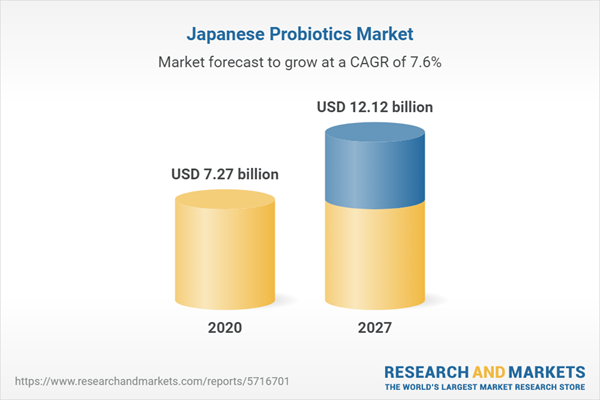Probiotics are living microorganisms that have health benefits when they are either consumed or applied to the body. Probiotics contain good bacteria that help in digesting food, destroy disease-causing cells, and produce vitamins. They also help in maintaining a healthy balance in the body. Naturally, probiotics are found in yogurt. The food and drug administration (FDA) regulates probiotics like foods, and not like medications. Probiotic intake is considered healthy and a smart choice among them due to its clinically proven health benefits.
Growing preventive healthcare in Japan
Japan is one of the most developed economies in the world. The country has developed despite having a lack of natural resources. Japan has always given importance to human resources; therefore, it has heavily invested in healthcare and education. The government has undertaken several measures toward preventive healthcare, such as the expansion of insurance coverage. In addition, the Japanese are well aware of the importance of incorporating probiotic bacteria and prebiotic ingredients in their daily diets. Furthermore, according to World Bank Data, Japan’s age dependency ratio reached 49% in 2021, which is an indication of the increasing aging population. This is fueling the demand for probiotics as probiotic supplements may be effective in counteracting age-related shifts as they help to restore the natural diversity of human gut bacteria, strengthen the immune system, and positively impact cognition and mood which impacts health outcomes and promote healthy aging.Market Developments
Therefore, the market players are making mindful investments and launches to expand the product offering for the market. For instance,- In February 2020, a Japanese prebiotics firm, Teijin formed an alliance with Chr. Hansen. The agreement allows Chr Hansen to supply probiotic ingredients to Teijin. The ingredients can be used in functional and health applications so that the supplement can be sold in the domestic/local markets. The probiotics-related products will be sold in the form of tablets, capsules, and powder sticks. Six different types of probiotic products will be marketed in the Japanese market.
- In June 2021, Yakult, a famous probiotic drinks brand expanded its product range in Japan. The brand launched new ice creams with its rich probiotic formula. A store was opened in Japan where several different Yakult ice creams were available for dine-in as well as takeaway.
COVID-19 Insights
The COVID-19 pandemic caused millions of deaths worldwide. It severely hampered the immunity of individuals. However, the pandemic had a positive impact on the Japanese probiotics market. As probiotics are known to restore a stable gut microbiota by regulating innate and adaptive immunity within the gut, they were used to combat COVID-19 because of several pieces of evidence that suggested that COVID-19 has an adverse impact on gut microbiota dysbiosis. Thus, probiotics were used for their antiviral properties as an adjunctive treatment to combat COVID-19. Several clinical trials were also undertaken, which proved the efficacy of probiotics and their metabolites in treating patients with the virus.Market Segmentation:
- By Type
- Lactobacillus
- Streptococcus
- Bifidobacterium
- Spore Formers
- Others
- By Form
- Liquid
- Dry
- By Application
- Functional Food and Beverages
- Dietary Supplements
- Animal Feed
- By End-User
- Human
- Animal
Table of Contents
1. INTRODUCTION1.1. Market Overview
1.2. COVID-19 Scenario
1.3. Market Definition
1.4. Market Segmentation
2. RESEARCH METHODOLOGY
2.1. Research Data
2.2. Assumptions
3. EXECUTIVE SUMMARY
3.1. Research Highlights
4. MARKET DYNAMICS
4.1. Market Drivers
4.2. Market Restraints
4.3. Porter's Five Forces Analysis
4.3.1. Bargaining Power of Suppliers
4.3.2. Bargaining Power of Buyers
4.3.3. Threat of New Entrants
4.3.4. Threat of Substitutes
4.3.5. Competitive Rivalry in the Industry
4.4. Industry Value Chain Analysis
5. JAPAN PROBIOTICS MARKET, BY TYPE
5.1. Introduction
5.2. Lactobacillus
5.3. Streptococcus
5.4. Bifidobacterium
5.5. Spore Formers
5.6. Others
6. JAPAN PROBIOTICS MARKET, BY FORM
6.1. Introduction
6.2. Liquid
6.3. Dry
7. JAPAN PROBIOTICS MARKET, BY APPLICATION
7.1. Introduction
7.2. Functional Food & Beverage
7.3. Dietary Supplements
7.4. Animal Feed
8. JAPAN PROBIOTICS MARKET, BY END-USER
8.1. Introduction
8.2. Human
8.3. Animal
9. COMPETITIVE ENVIRONMENT AND ANALYSIS
9.1. Major Players and Strategy Analysis
9.2. Emerging Players and Market Lucrativeness
9.3. Mergers, Acquisitions, Agreements, and Collaborations
9.4. Vendor Competitiveness Matrix
10. COMPANY PROFILES
10.1. Yakult
10.2. Asahi Group Holdings, Ltd.
10.3. Nissin Food Products Co., Ltd.
10.4. Kirin Holdings Company, Limited.
10.5. Morishita Jintan Co., Ltd
*List is not exhaustive
Companies Mentioned
- Yakult
- Asahi Group Holdings, Ltd.
- Nissin Food Products Co., Ltd.
- Kirin Holdings Company, Limited.
- Morishita Jintan Co., Ltd
Table Information
| Report Attribute | Details |
|---|---|
| No. of Pages | 78 |
| Published | December 2022 |
| Forecast Period | 2020 - 2027 |
| Estimated Market Value ( USD | $ 7.27 billion |
| Forecasted Market Value ( USD | $ 12.12 billion |
| Compound Annual Growth Rate | 7.5% |
| Regions Covered | Japan |
| No. of Companies Mentioned | 5 |









